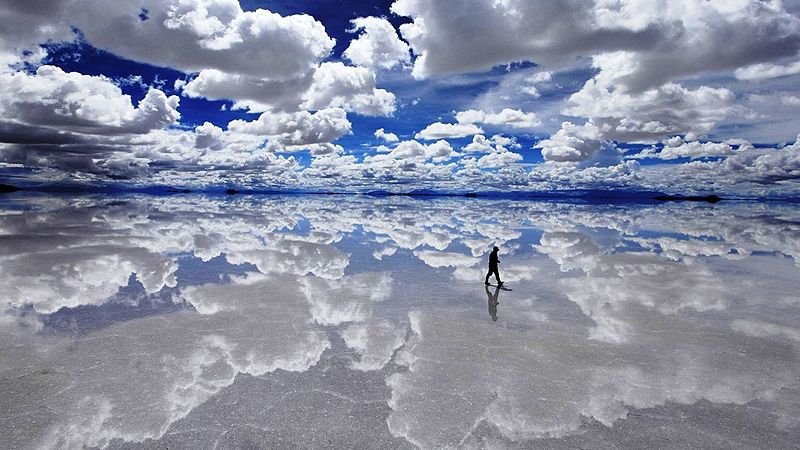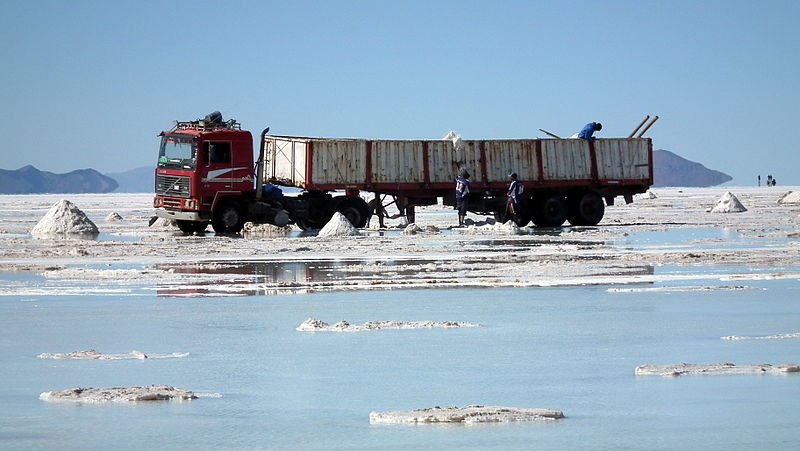Welcome to another post of our weird planet! When we hear the word desert we immediately think of an infinite area covered with sand as far as the eye can see. But what would you think if I told you that there is a place, a desert up in the mountains, where all the sand has been replaced by...salt?

(Image source - Author, Luca Galuzzi/Lucag/http://www.galuzzi.it - License)
Salar ("salt flat" in spanish) de Uyuni (a town you pass before getting to the lake) is a vast area of salt crust 12,000 feet above sea-level in Bolivia (South America). It is the remnants of an ancient lake that evaporated. Spread over the bolivian Altiplano (a high plateau the Andes created during their formation), Salar de Uyuni originates from prehistoric lake Minchin (a real giant that existed 30 - 42 thousand years ago). The mountains of the area led water to run down and collate in the basin that formed Minchin. The place went through many transformations over time. Lake Minchin became Paleo Lake Tauca, which in turn became the prehistoric lake Coipasa. When Coipasa dried, two lakes (Poopó and Uru Uru) were left behind along with two salt deserts (Salar de Uyuyni and Salar de Coipasa).
As the water evaporated under the fierce sun and the dry climate of the Andes, massive salt deposits were left behind. Beneath the salt crust (as thick as a few centimeters to a few meters) you'll find mud mixed with salt and brine. In the brine you'll also find sodium, lithium, potassium and magnesium in their chloride form (NaCl, LiCl, KCl, MgCl2). There are also some "islands" on the lake, peaks of inactive, ancient volcanoes.
The area doesn't have great temperature changes. They may range from a peak of 21°C (November to January) to 13°C (June), but nights are always cold in the dry Andes (−9 and 5 °C). Humidity levels are low and so is rainfall (with an average of less than 5 days/month even during the rainy season).
Seasons change
The place undergoes through two main changes, the dry and the wet season. In the dry season (May to November) it gets colder and the lake's floor is a hard salty plate. On the other hand, during the wet season (December to April), nearby Lake Titicaca usually floods, it overflows into Poopó and Poopó transfers water to the salt desert. Water covering the vast (almost 10.500 square kilometers) salt plain creates a wondrous sight as it plays the game of reflections in its own, unique way.

(Image source - Author, Yellow531 - License)
A tourist attraction
The beauty of the place has been a call for many nature-loving tourists. Tours are organised all year long. Keep in mind that in such high altitudes it is common to get altitude sickness (difficulty in breathing due to the lack of oxygen), so it would be advisable to discuss it with your doctor before going there. (Oh! and before checking trivago, booking or tripadvisor, watch this tour of a "salty" hotel in Salar de Uyuyni made of salt, in case you're interested in something not that common.)
No matter the season though, Salar de Uyuni is the ideal site for professional and amateur photographers. Check this amazing photo collection from huffingtonpost.com.
Satellite calibration
Just like huge ice sheets, the salt flats of Salar de Uyuni offer the perfect chance to calibrate the equipment we use to measure distance in satellites (because of the stability and strong reflection they provide). There are several places on earth that serve as natural calibrating targets, but you can also find some man-made.
The fear of unemployment
For years the saleros (salt miners) have been working on the lake extracting salt and selling it for further processing before it ended up in people's kitchens. Now, their jobs are in danger. The lake has almost 50% of the world's lithium reserves and the government has expressed wishes to set a state-run company to mine it. Lithium is widely used in batteries, smartphones and other gadgets and if a new field (lithium extraction) was created, Bolivia developing its industrialization would be the greatest benefit.

(Image source - Author, Albert Backer - License)
References
nationalgeographic.com
beautifulworld.com
boliviahop.com
wikipedia.org
telesurtv.net
aljazeera.com

Thank you for stopping by and giving this post a read. I hope you enjoyed it! If it got your curiosity-radar on, you can read some of the previous articles on this series:
29 - Light Pillars
30 - Earthquake Lights
31 - Fairy Circles
32 - Desert Roses
33 - Barbie's Lake
Feel free to check out my blog for more posts that might intrigue you! :)
Special thanks and mentions:

Until my next post,
Steem on and keep smiling, people!

